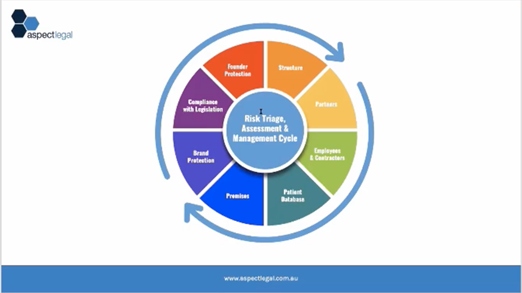Proven Practice Strategies for Growing Healthcare Businesses
Sep 27, 2021
“Begin with the end in mind” is habit number 2 in Steven Covey’s 7 Habits of Highly Effective People.
Starting a healthcare practice is no mean feat; clever owners will build in flexibility, with the end goal in mind, ensuring the practice is successfully sold at its peak. To achieve this, strategic business planning is an absolute must for every practice. With your vision and objectives clearly defined and your course mapped, you’ve begun with the end in mind. Your clearly defined strategies will help you get there.
Here, our experts reveal strategies you need to add value to your healthcare practice, ensuring security, peace of mind and a healthy return on investment.
Creating value with legal, financial, and technological strategies
Legal
Joanna Oakey, Managing Director at Aspect Legal, says some owners find when selling, that their asset does not have the value they expected. “To mitigate this, make sure you have a vision when you start off where you want the practice to be when you sell,” she says.
Starting with the end in mind, business partners should agree, from the outset, about exit timings. Disputes between owners are common but can mostly be avoided simply by good, timely communication and documented agreements for asset protection.
Financial
One important thing to understand is that people want to buy a growing business. Knowing this will help your decision-making, ensuring your business is growing and in good shape when it’s time to sell. Brendan Campbell, Director of Business Services and Taxation at Prosperity Health, says you should know how much your business is worth. A business valuation, 3-5 years before you exit, can be used to correct any previous non-productive strategies, and ensure you are showing decent profits.
“Another point to consider is that you, the owners, may all be different ages, with different goals and at different stages of your careers. It’s essential you communicate well and understand each other. Document everything, reviewing it periodically to keep it up to date,” he says.
Data
Data allows for measurement and analysis; it tells your practice story in real time. A key consideration is that good datasets strengthen valuations by demonstrating the available growth potential to buyers. Understanding the data is key.
Shannon Murphy, Director at KPeyes says the KPeyes system powerfully pulls underutilised data and information from practice management systems (PMS) to a simple dashboard displaying key performance indicators (KPI). Data can be extracted for valuations, creating reports showing historical performance. These reports can be used to expose inefficiencies, enable corrections, and guide improvements, saving time and money.
Take these steps to boost and protect productivity and profits
Review, review, review
Without a doubt, regularly reviewed healthcare businesses will be more successful. A recent poll, conducted during Practice Success Collective’s Practice Strategy webinar, showed 39% of voters reviewed their practice KPIs annually, 33% of voters reviewed them quarterly and 28% monthly. Why not review one aspect of your business as a PDSA cycle for your QI PIP?
Know your fundamental practice drivers
According to Brendan Campbell, the key drivers of a general practice are:
- Billings - 65% to the GPs
- Nurse and administration costs - 22% of billings
- Better run practices – 14% of billings
- Rent - 5-6% of billings
- Chronic disease management (CDM)
- Technology - automating and streamlining administrative processes, including doctor disbursements
“To gauge how well you are doing in comparison to other practices use benchmarking reports,” says Brendan. “This can help you identify gaps in your strategy,” he says.
Exit easily
“Medical practice valuations mostly use the cap rate/EBIT model. When selling in-house, it can be up to 3 EBIT multiples; Sydney is a bit higher in the market. And it’s important to be aware that if you’re selling to a corporate, though you receive more financially it comes with conditions, such as 3-5 year “earn outs”.
You need to be aware that the more CDM you do, the higher the income. If your staff costs are nearer to 14% then with income increased through CDM, better technology and onsite pathology, this means a higher valuation. When you sell, there’s a multiplier effect — it exponentially gets bigger and bigger,” he says.
Case study: “A GP client had an exit strategy where he sold 25% to two other doctors working in the practice. In this way, the GP reduced his equity to 50% ownership and reduced his workdays, while the other two doctors steadily took over. The strategy worked well in this case,” says Brendan.
Numbers Don’t Lie
Technology integration is a big plus for valuation, paying big dividends. Shannon Murphy says technology enhances a business and takes it to the next level. Some owners neglect to update their systems, however this is false economy.
“When you invest in IT systems you’ll be viewed more positively. Compliance aspects and reporting can be more easily monitored and contribute to transparency,” he says.
“Also, don’t underestimate CDM, where technology plays a big part in identifying gaps in patient care,” he says. “In a 5 GP practice, if each GP does even one more care plan per week, there’s another $100,000 income, resulting in a big increase in valuation and sale price. Numbers don’t lie,” he says.
Value Destroyers
“Sometimes practices need selling when least expected, so it’s important to run the practice in a sale-ready state,” says Joanna Oakey. That’s why it’s important to have all the drivers of market value within your practice.
The Risk, Triage, Assessment & Management Cycle is a helpful tool for identifying risk.

Each of the 8 segments represent an area of potential issue; consider each one to guard against value leakage and loss.
Partners are one area where leakage is common. “It all comes back to ownership structure,” says Joanna. “Partnership disputes are very common and destroy value. It’s important all partners understand the practice profit structure; good communication is essential for prevention of disputes,” she says.
In conclusion, start your practice with the end in mind. To grow your practice and sell at its peak, you must have a clearly defined pathway and documented strategies to help you get there. You’re a highly trained health professional; your focus is on patient health; you’re not expected to be a seasoned business specialist. Our Practice Success Collective team of experts are here to help you with professional and time-saving advice; they’ll guide you every step of the way.
Joanna Oakey
Managing Director, Aspect Legal
02 8006 0769
Brendan Campbell
Director of Business Services and Taxation, Prosperity Health
07 3007 1900
Shannon Murphy
Director, KPeyes
1300 200 379

